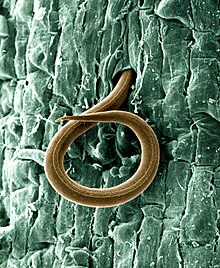Purpureocillium lilacinum
| Purpureocillium lilacinum | |
|---|---|

| |
| Divergent phialides and long, tangled chains of elliptical conidia borne from more complex fruiting structures characteristic of Purpureocillium lilacinum; magnification 460X. | |
| Scientific classification | |
| Domain: | Eukaryota |
| Kingdom: | Fungi |
| Division: | Ascomycota |
| Class: | Sordariomycetes |
| Order: | Hypocreales |
| Family: | Ophiocordycipitaceae |
| Genus: | Purpureocillium |
| Species: | P. lilacinum
|
| Binomial name | |
| Purpureocillium lilacinum (Thom) Luangsa-ard, Hou- braken, Hywel-Jones & Samson (2011)
| |
| Synonyms[2] | |
|
Paecillium Luangsa-ard, Hywel-Jones & Samson nom. prov. (2007)[1] | |
Purpureocillium lilacinum is a species of filamentous
Taxonomy and phylogeny
The species was originally described by American mycologist
Description
Purpureocillium lilacinum forms a dense
Life cycles
Purpureocillium lilacinum is highly adaptable in its life strategy: depending on the availability of nutrients in the surrounding microenvironments it may be
Human pathogenicity
Purpureocillium lilacinum is an infrequent cause of human disease.[15][16] Most reported cases involve patients with compromised immune systems, indwelling foreign devices, or intraocular lens implants.[17][18] Research of the last decade suggests it may be an emerging pathogen of both immunocompromised[19] as well as immunocompetent adults.[20] It is one of the most common species causing hyalohyphomycosis along with Paecilomyces variotii.[9]
Biocontrol agent

Plant-parasitic nematodes cause significant economic losses to a wide variety of crops. Chemical control is a widely used option for plant-parasitic nematode management. However, chemical nematicides are now being reappraised in respect of environmental hazard, high costs, limited availability in many developing countries or their diminished effectiveness following repeated applications.
Control of plant-parasitic nematodes
Purpureocillium lilacinum was first observed in association with nematode eggs in 1966[21] and the fungus was subsequently found parasitising the eggs of Meloidogyne incognita in Peru.[22] It has now been isolated from many cyst and root-knot nematodes and from soil in many locations.[23][24] Several successful field trials using P. lilacinum against pest nematodes were conducted in Peru.[22] The Peruvian isolate was then sent to nematologists in 46 countries for testing, as part of the International Meloidogyne project, resulting in many more field trials on a range of crops in many soil types and climates.[25] Field trials, glasshouse trials and in vitro testing of P. lilacinum continues and more isolates have been collected from soil, nematodes and occasionally from insects. Isolates vary in their pathogenicity to plant-parasitic nematodes. Some isolates are aggressive parasites while others, though morphologically indistinguishable, are less or non-pathogenic. Sometimes isolates that looked promising in vitro or in glasshouse trials have failed to provide control in the field.[26]
Enzymes
Many
Egg infection
Before infecting a nematode egg, P. lilacinum flattens against the egg surface and becomes closely
Mycotoxins
Paecilotoxin is a mycotoxin isolated from the fungus.[30] Its significance is unknown. Khan et al. (2003) tested one strain of P. lilacinum for the production of paecilotoxin and were unable to show toxin production in that strain, suggesting that toxin synthesis may vary among isolates.[31][32]
References
- ISBN 978-3-9803083-8-0.
- ^ a b "Paecilomyces lilacinus (Thom) Samson 1974". MycoBank. International Mycological Association. Retrieved 2011-07-17.
- PMID 26734546.
- ^ a b c Samson RA. (1974). "Paecilomyces and some allied hyphomycetes". Studies in Mycology. 6: 58.
- ISBN 978-3-9803083-8-0.
- ^ Thom C. (1910). Bulletin of the Bureau of Animal Industry US Department of Agriculture. 118: 73.
{{cite journal}}: Missing or empty|title=(help) - .
- PMID 18490993.
- ^ PMID 21631575.
- ISSN 0046-225X.
- S2CID 25132425.
- S2CID 39116161.
- S2CID 20548355. Archived from the original(PDF) on 2012-04-25. Retrieved 2018-07-23.
- .
- PMID 9431388.
- PMID 8735119.
- PMID 299984.
- PMID 7190003.
- PMID 11981740.
- ^ Carey J, D’Amico R, Sutton DA, Rinaldi MG. Paecilomyces lilacinus vaginitis in an immunocompetent patient. Emerg Infect Dis [serial online] 2003 Sep
- ^ Lysek H. (1996). "Study of biology of geohelminths. II. The importance of some soil microorganisms for the viability of geohelminth eggs in the soil". Acta Universitatis Palackianae Olomucensis. 40: 83–90.
- ^ a b Jatala P, Kaltenbach R, Bocangel M (1979). "Biological control of Meloidogyne incognita acrita and Globodera pallida on potatoes". Journal of Nematology. 11: 303.
- ^ Stirling, GR (1991). Biological Control of Plant Parasitic Nematodes. UK: CABI Publishing. p. 282.
- S2CID 34778287.
- .
- ^ Gomes Carniero RMD, Cayrol J (1991). "Relationship between inoculum density of the nematophagous fungus Paecilomyces lilacinus and control of Meloidogyne arenaria on tomato". Revue de Nématologie. 14 (4): 629–34.
- PMID 7773385.
- .
- ^ Money NP. (1998). "Mechanics of invasive fungal growth and the significance of turgor in plant infection". Molecular genetics of host-specific toxins in plant disease. Netherlands: Kluwer Academic Publishers. pp. 261–71.
- S2CID 681219.
- PMID 14568155.
- S2CID 38406684.
External links
 Media related to Purpureocillium lilacinum at Wikimedia Commons
Media related to Purpureocillium lilacinum at Wikimedia Commons Data related to Ophiocordycipitaceae at Wikispecies
Data related to Ophiocordycipitaceae at Wikispecies
